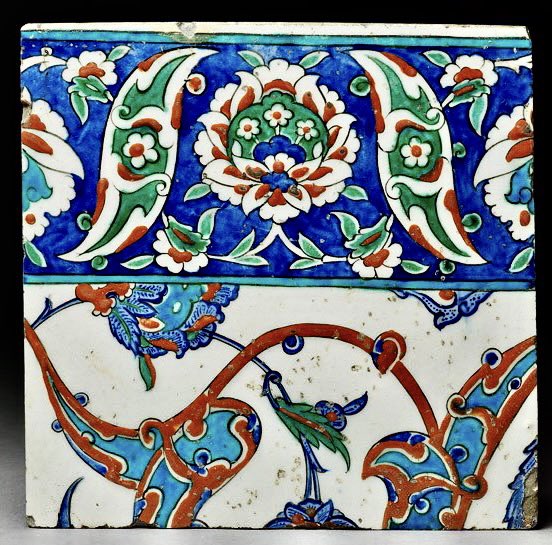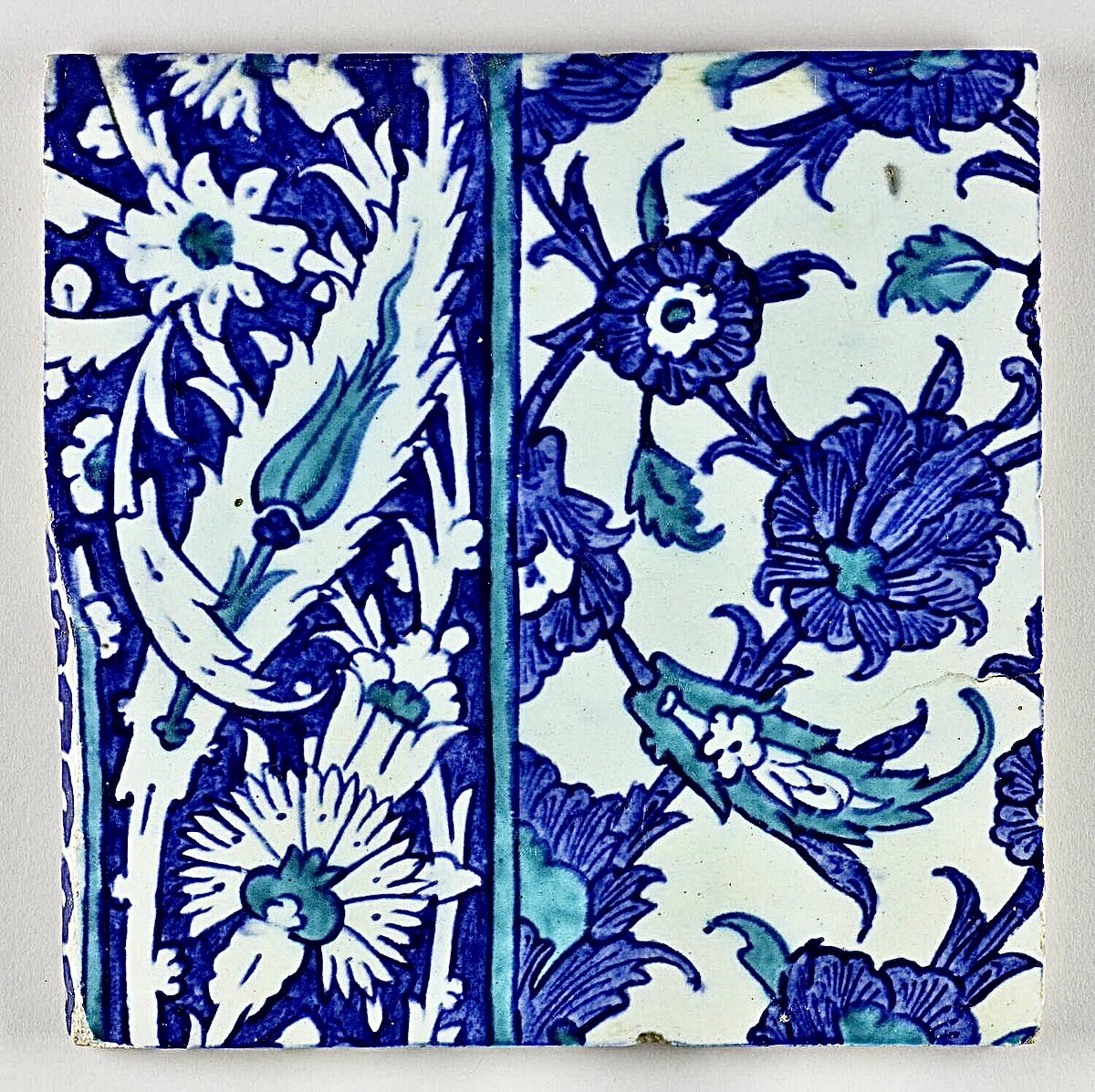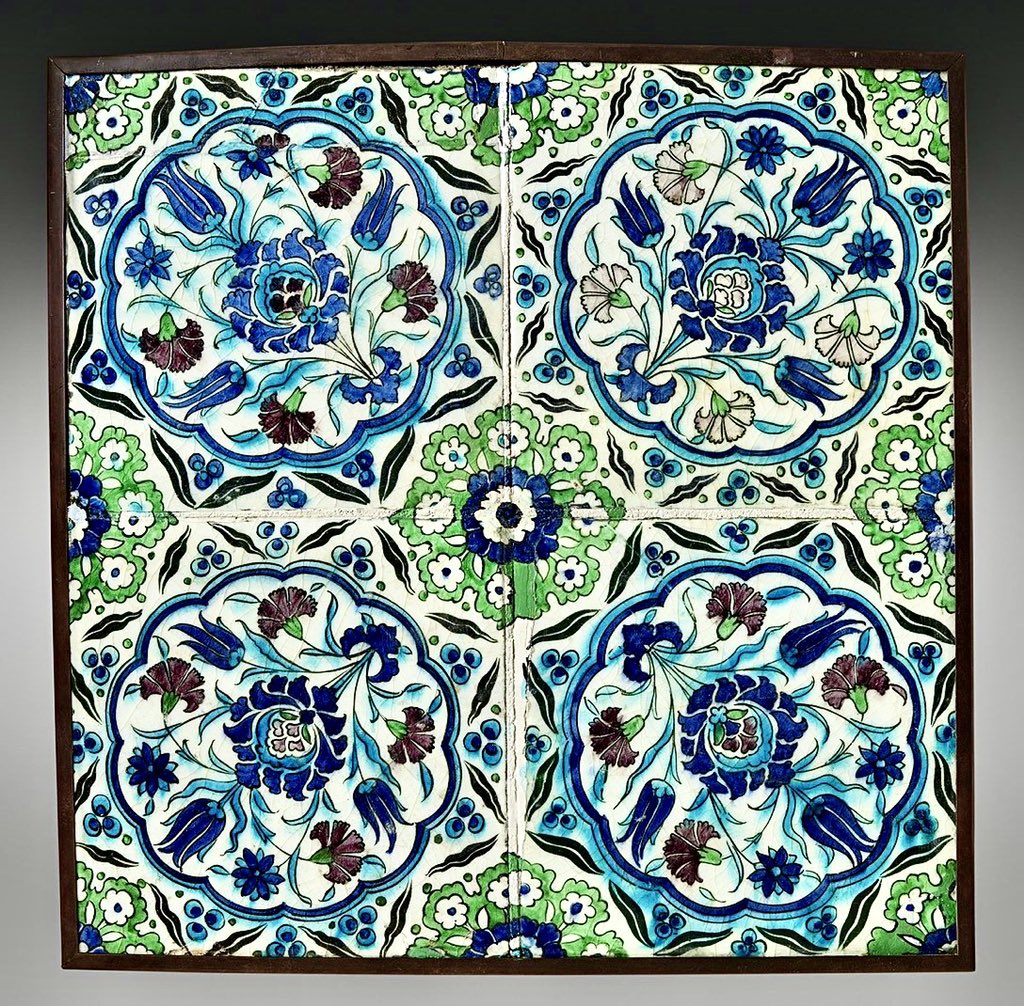İznik is a town in northwestern Turkey, renowned for its Ottoman-era hand painted ceramics & tiles.
İznik tiles decorated walls of shrines, mosques & palaces.
For #TilesOnTuesday here are 24 exquisite examples in museums & collections across the world…
A thread…
İznik tiles decorated walls of shrines, mosques & palaces.
For #TilesOnTuesday here are 24 exquisite examples in museums & collections across the world…
A thread…

1/ Two Iznik Tiles with Continuous Floral Pattern
Ottoman dynasty (1299–1923), c.1560
Pattern typical of the ‘saz style’ a term that derives from the words saz kalem, or “reed pen.” The style developed in album drawings in black ink during second half of 16thc.
@artinstitutechi
Ottoman dynasty (1299–1923), c.1560
Pattern typical of the ‘saz style’ a term that derives from the words saz kalem, or “reed pen.” The style developed in album drawings in black ink during second half of 16thc.
@artinstitutechi

2/ Iznik tile, 1560-1600, Ottoman, Turkey
Tile-work was normally used to provide rich splashes of colour on building exteriors, or to emphasise important areas of the interiors.
@V_and_A
Tile-work was normally used to provide rich splashes of colour on building exteriors, or to emphasise important areas of the interiors.
@V_and_A

4/ Iznik tile, Turkey, 16th Ottoman
Decorated with confronted parrots framed by a dense border of flowers. The emerald green was used for the first time in 1566/7 on the tiles of the mausoleum of Suleyman the Magnificent
@TheBenakiMuseum
Decorated with confronted parrots framed by a dense border of flowers. The emerald green was used for the first time in 1566/7 on the tiles of the mausoleum of Suleyman the Magnificent
@TheBenakiMuseum

7/ Iznik tile, 16th c. Ottoman
Turkey: Marmara Region: Bursa
Design of winged sausages alternating with heart-shaped lotus medallions and undulating scroll of prunus blossom,roses.
@britishmuseum
Turkey: Marmara Region: Bursa
Design of winged sausages alternating with heart-shaped lotus medallions and undulating scroll of prunus blossom,roses.
@britishmuseum

8/ Iznik tiles, 1560, Ottoman, Turkey
These tiles are part of a repeat-pattern composition, an example of which adorns the walls of the sixteenth-century Rüstem Pasha Mosque in Istanbul.
@AgaKhanMuseum
These tiles are part of a repeat-pattern composition, an example of which adorns the walls of the sixteenth-century Rüstem Pasha Mosque in Istanbul.
@AgaKhanMuseum

9/ Iznik tile Unknown maker/s, Turkey 1575-1600 CE Buff coloured fritware, coated in a white slip and painted with red, green, blue and black glaze.
@FitzMuseum_UK
@FitzMuseum_UK

10/ Iznik tile, Turkey (Iznik), late 16th century Ottoman
Square glazed grey earthenware tile decorated in polychrome with a design of a pheasant perched on a flowering tree, within a lobed panel with arabesques at the corners
@V_and_A
Square glazed grey earthenware tile decorated in polychrome with a design of a pheasant perched on a flowering tree, within a lobed panel with arabesques at the corners
@V_and_A

11/ Iznik tile, Turkey, 16th, Ottoman
The emerald green was used for the first time in 1566/7 on the tiles of the mausoleum of Suleyman the Magnificent
@smithsonian
The emerald green was used for the first time in 1566/7 on the tiles of the mausoleum of Suleyman the Magnificent
@smithsonian

12/ Iznik tile Unknown maker/s, Turkey 1575-1600 CE Buff coloured fritware, coated in a white slip and painted with red, green, blue and black glaze.
@FitzMuseum_UK
@FitzMuseum_UK

16/ Iznik tile panel, 1580, Ottoman, Turkey
These tiles are from the baths at the mosque of Eyüp Ansari in Istanbul.
@V_and_A
These tiles are from the baths at the mosque of Eyüp Ansari in Istanbul.
@V_and_A

23/ Iznik calligraphic tile, Ottoman Turkey, CIRCA 1570
Sold for GBP £90,000 at auction in 2020
@ChristiesInc
Sold for GBP £90,000 at auction in 2020
@ChristiesInc

24/ Recently, this highly rare Iznik tile circa 1575, depicting the birds of paradise, sparked a bidding battle to bring £655,200, more than six times its pre-sale estimate @Sothebys
#SothebysMiddleEast
#SothebysMiddleEast

• • •
Missing some Tweet in this thread? You can try to
force a refresh


































